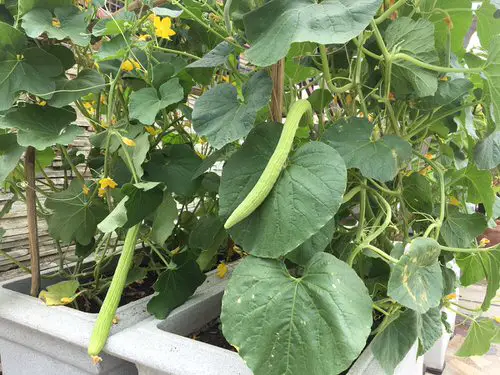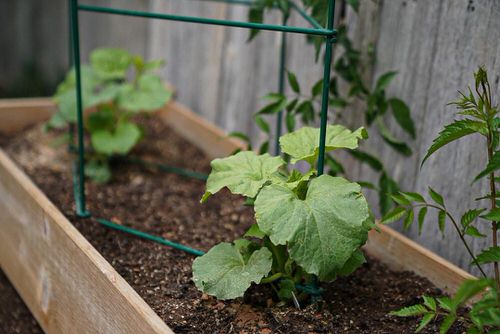Growing Armenian Cucumbers in Containers is fun and this way, you will be able to enjoy a bountiful organic harvest in your own little garden!

Also called the Snake Cucumber, this is a very popular plant that is grown in most Lebanese homes. It is a must-have in any garden as it is easy to grow, productive, and heat tolerant, and has a mild, crisp taste! Let’s have a look at all the information on Growing Armenian Cucumbers in Containers.
Botanical Name: Cucumis melo var. flexuosus
Common Names: Snake Melon, Snake Cucumber, Yard-long Cucumber, Armenian Cucumber
USDA Zones: 4-10
Here are the best types of cucumber you can grow
Propagating Armenian Cucumber
You can grow Armenian Cucumbers through seeds. If you want to cut down the time, you can also purchase a plant from a nursery.
- Cucumbers are heat-loving plants. If you live in a cold climate, start the seeds indoors, 4-5 weeks before you plan to move the pot outdoors, when the climate becomes warm. You will have to move the pot indoors again if the outside temperature drops below 5 °C (41 °F). If you live in a hot climate, you can grow the seeds anytime.
- Avoid transplanting the plant as Armenian cucumber doesn’t respond well to it.
- Growing the plant from seeds is a pretty straightforward process.
- Sow the seeds in a pot with a quality potting mix, water well, and keep it where it can get bright, indirect light. If you want to speed up the germination process, use a heating mat.
- For growing seeds directly in the garden, pick a bright spot. Also, before sowing, wait until the last frost date in your area has passed.
- As the plant grows, make sure there is a trellis or organic pole installed, so the vines can climb freely and look stunning in a container.
Choosing a Pot
A 16-20 inches pot will serve most of the varieties, giving enough space for the roots to develop well. It will also help to hold a large amount of soil with water, which is necessary for the good development of cucumbers.
Growth Habit

The best way to grow these plants is vertical. It gives you two advantages – first, the plant takes less space and second, the cucumbers grow straight as they are suspended. Growing vertically also helps you reduce the chances of pests and diseases. As these plants climb very easily, pole, trellis, or any type of vertical support will be more than enough.
We have a great article on why you must grow cucumbers vertically here
Best Armenian Cucumber Varieties to Grow
- Striped Armenian: It produces long, slender 8-16 inches long fruits that are dark green in hue with pale stripes all around.
- Light Green: This is probably the most accessible variety and widely available. The Light Armenian Cucumber has a bountiful harvest that produces large pale green ridged 12-16 inches long fruits.
- Dark Green: It offers a mild taste. This variety is not as popular, but people are slowly inching towards it. The fruits can be 14-26 inches long.
- Carosello Barese: This Italian variety has a crisp and fresh flavor. The cucumbers are compact, oval-shaped and 12-24 inches long.
- Mandurian Round Carosello: It offers round fruits. The skin has light and dark streaks with mild flesh. You can harvest when they are 2-3 inches long.
Requirements of Growing Armenian Cucumbers in Containers

Location
This plant loves the sun and if you want a bountiful harvest, make sure that it is exposed to a minimum of 4-5 hours of sunlight. The plant won’t tolerate temperatures below 50 F (10 C) and does best in the range of 60–95 F (15–35 C).
Soil
Go for a well-draining, loose soil, rich in organic matter and a pH between 5.5 to 6.8. You can also mix equal parts of potting soil, peat moss, compost, and perlite. Side dressing the pot compost and manure during flowering will also help.
Prior to growing Armenian cucumbers, amending the soil with compost and manure would be a good idea.
Water
For the best fruits, make sure that you are keeping the plant well-watered. This doesn’t mean that you should over-water the plant. Strike the right balance of watering so that the soil is never dry and always moist. The best method to follow is to touch the top 1-2 inches of soil with your finger. If it feels dry, water the plant well.
As cucumbers are more than 95% water, the plant surely needs to be watered well all the time. Mulching will help to slow down the water evaporation.
Armenian Cucumbers Care
Fertilizer
To allow maximum production, use a balanced feed like 10-10-10 during the initial growth. Once the plant starts to flower, use low nitrogen with high potassium and phosphorus feed after a week, and then once every 3-4 weeks. Do follow the instructions on the label for dosage.
Pests and Diseases
Be careful of spotted cucumber beetles. They can destroy the plant in no time. Simply handpick and squish them or use insecticidal soap to get rid of them. To keep the plant safe from diseases, use carbaryl or pyrethrum organic control.
Harvesting Armenian Cucumber

The right time to harvest the plant is when the cucumbers grow 8-10 inches long. The length also depends on the variety. You can also tap on the cucumber to see if they are hard and feel crisp to touch. Do not wait for too long as with time, the cucumbers turn bitter in taste. Do not pull the fruits carelessly from the plant–use a scissor to clip them as this will avoid damage to the plant.
Armenian Cucumber Companion Plants
Choosing the right companion plants for Armenian cucumbers will help in pest protection and improve the nutrients of the soil. They also aid in attracting beneficial insects. The best companion plants are Sweet Pea, Radish, Marigold, Sunflower, Corn, and Nasturtium.



Amazing idea! I enjoyed reading your blog. Thanks for sharing such an informative post.
Thank you for the helpful information about Armenian cucumbers. With how much you know about Armenian cucumbers, perhaps you could tell me something. Do you prefer the light, the Dark, the Striped (Painted Serpent) or the Facussa? I know that there are more types than this, but I just thought I would ask you about your favorite.